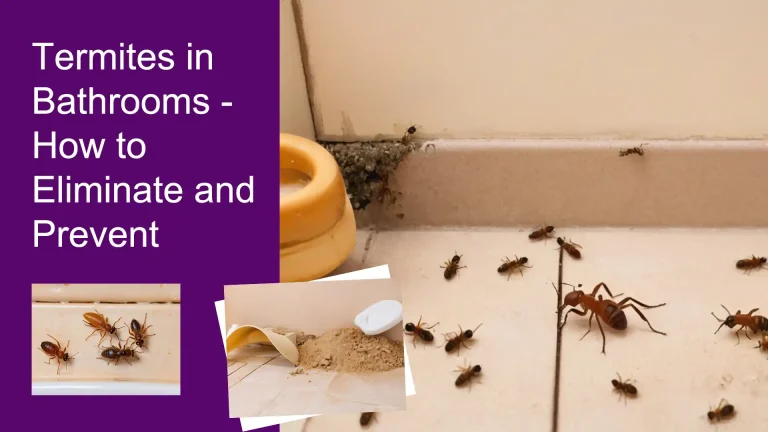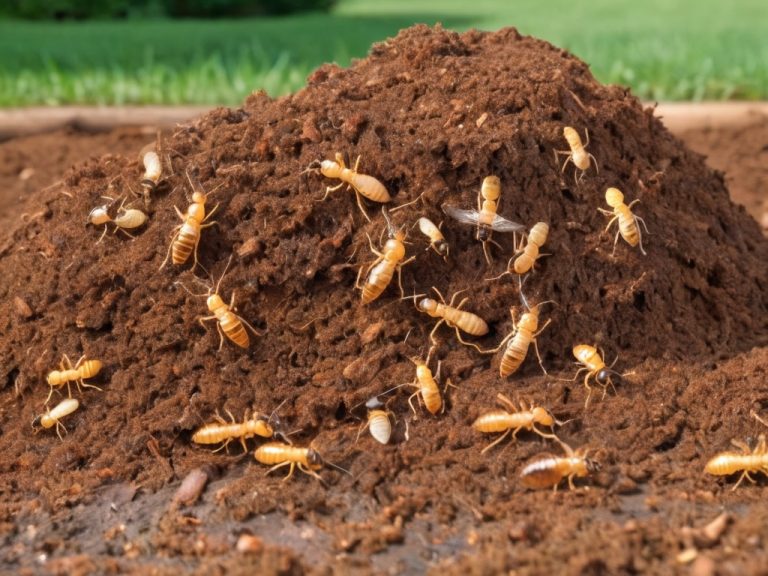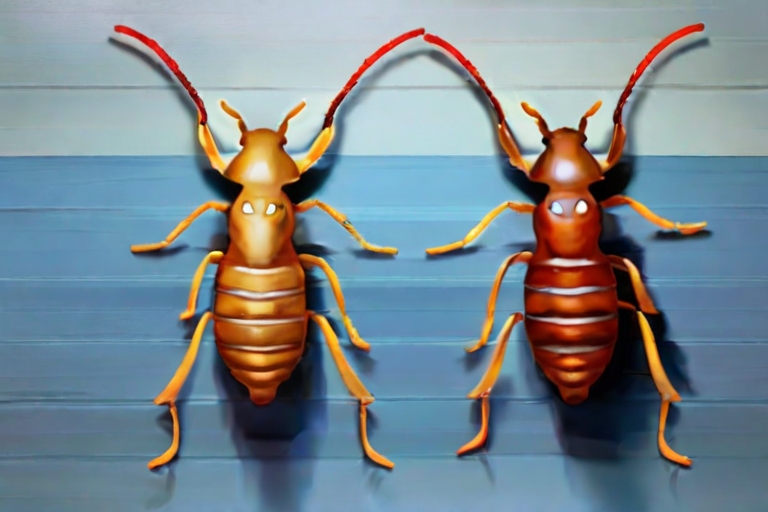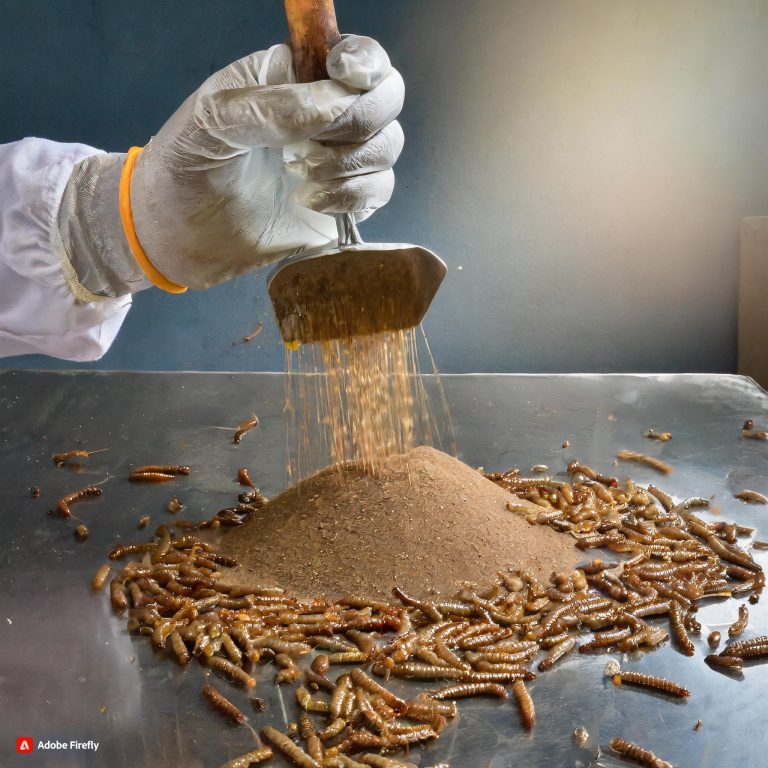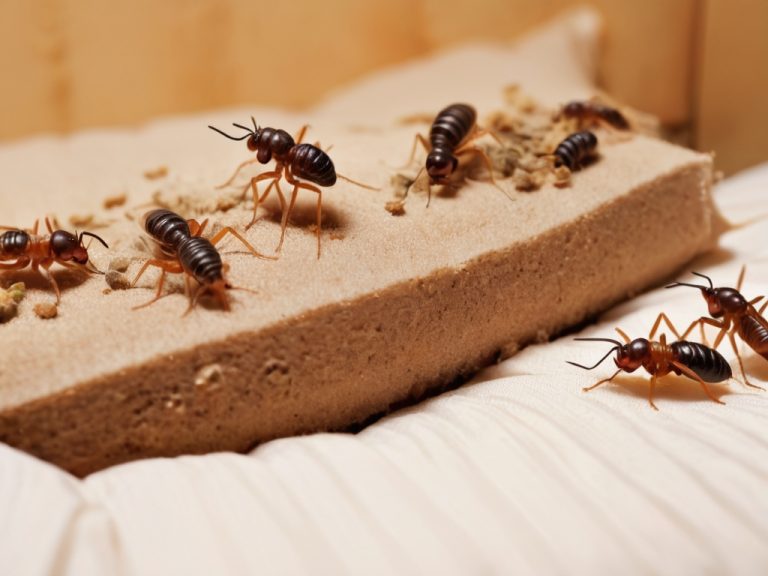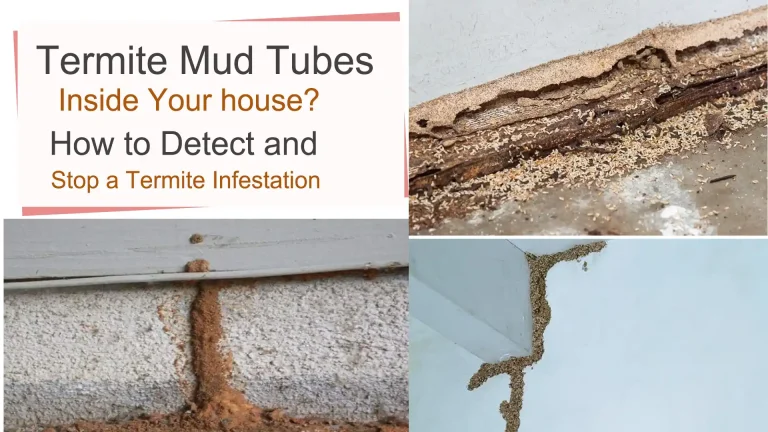5 Simple Steps to Ged Rid and Prevent Termites in Firewood
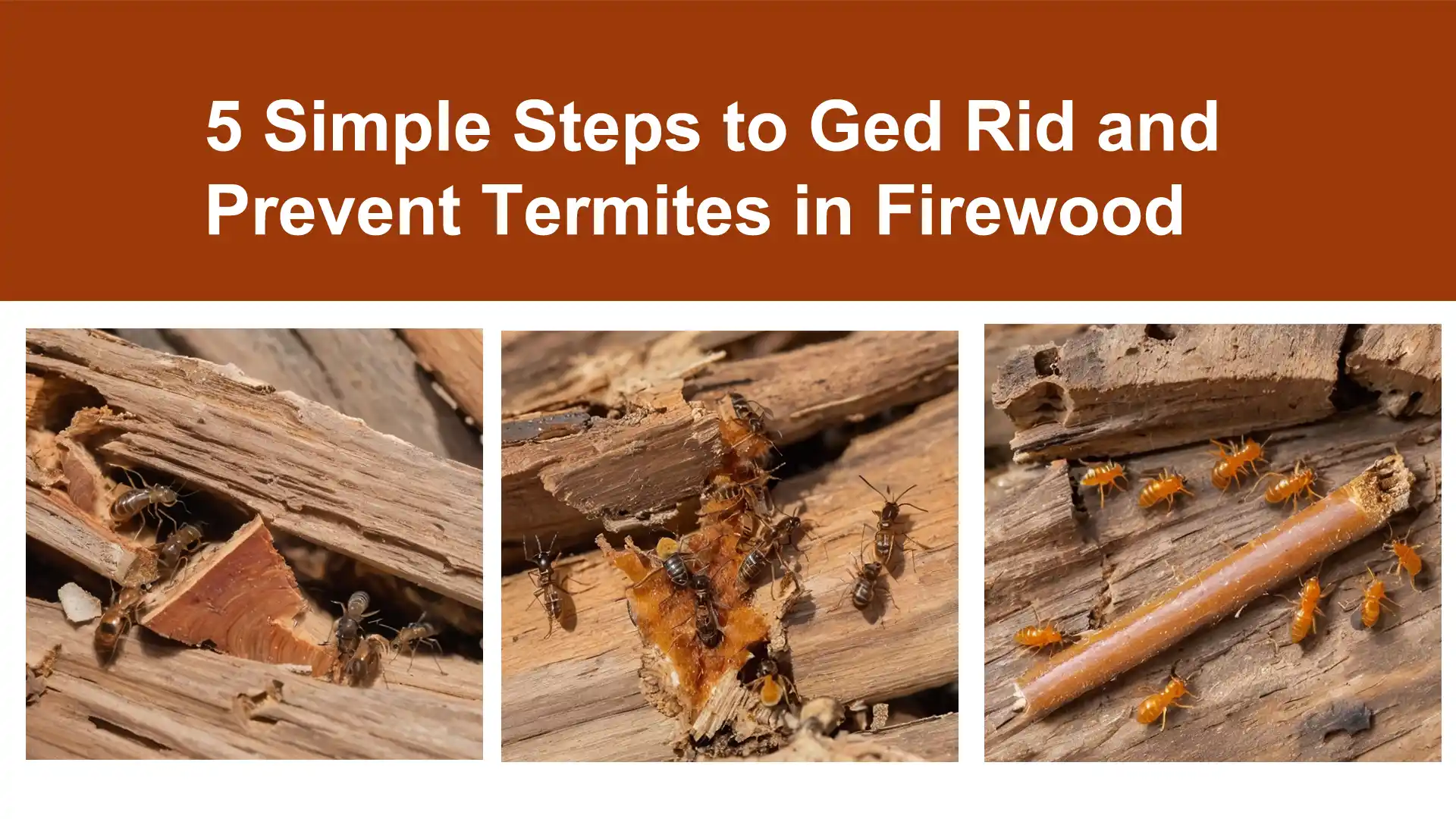
- Step 1: Regularly Inspect Wood for Early Warning Signs
- Step 2: Store Firewood Above Ground Away from Structures
- Step 3: Identify Termite Species Plaguing Your Firewood
- Step 4: Apply Pesticide & Insecticide Solutions
- Step 5: Replace Highly Infested Firewood Whenever Necessary
- Signs of Termites in Firewood
- How to Tell if Termites Are in Firewood
- Does Firewood Attract Termites?
- Can You Burn Firewood With Termites?
- Conclusion
Finding signs that your prized firewood pile has become infested with destructive termites can be disheartening. Left unchecked, they can destroy your termites in your firewood stores, spread to your home, and persist year after year if preventative measures aren’t also taken. So knowing how to get rid of termites from your firewood while keeping future infestations at bay is crucial. Follow these 5 important steps to rid your logs of pests for good.
Step 1: Regularly Inspect Wood for Early Warning Signs
Carefully examining your stack of firewood routinely for evidence of termites is the first line of defense. Catching an infestation early on when it is small gives you the best chance of destroying it before wide-scale damage is done.
Be on the lookout for these common early find termites:
- Mud Tunnels: Subterranean termites create narrow earthen tubes only about a 1⁄4 to 1⁄2 inch wide that they use to traverse over wood and other surfaces from their underground colonies up to the food source. Finding mud tunnels on or near your firewood is often the first visible clue to their presence.
- Hollow Sounding Wood: Tapping logs with the handle of an axe or mallet should produce a nice solid “thunk” sound. If you instead hear a more hollow, almost papery-sounding noise it can signify interior damage and possible termite activity inside the wood eating away at the wood fibers.
- Frass Leftovers: This sawdust-like cellulose byproduct called “frass” is what termites excrete from digesting the wood. Seeing piles of it accumulating on or near your firewood pile is not a good sign.
- Peeling Bark: When tree bark starts detaching or pulls away more easily from the logs, it usually indicates termites tunneling around just underneath, severing connecting tissue.
- Swarming Winged Termites: During spring and summer when the mating flights commence, watch closely for swarms of winged termites emerging around woodpiles. Usually the first phase of new colony foundation.
- Pencil-Sized Earthen Tubes Sticking Out of Crevices: When drywood species attack firewood, they work their way into cracks and crevices, extruding these narrow mud tubes from their burrows to the outside air. Spotting them protruding signals plenty going on below the surface.
Make inspecting the condition of your entire firewood pile a regular routine – especially scanning underneath logs on bottom levels most vulnerable to ground pest entry. Act swiftly to treat any issues found before they intensify.
Step 2: Store Firewood Above Ground Away from Structures
To make your woodpile far less appealing to all varieties of termites, store it at least 12 inches off the firewood off the ground above ground level using pallets or blocks. Many are unable to scale smooth vertical surfaces while others lose scent tracking ability once separated from soil contact or leaf litter food sources.
Strategic off the ground firewood storage also serves to:
- Impede termites from being able to directly tunnel upwards into the stack from their subterranean colonies where the termites live. Forces them to need to build fragile exposed mud tube bridges to reach.
- Allow for easier detection of termite activity like termites build mud tunnels by raising pile of firewood up into view versus directly on the ground.
- Prevent inherent moisture transfer from earth & added sunshine further drying wood.
- Provides convenient anchor points to apply termiticide liquid or powder treatments forming outer protective barrier band.
Pallets and cinder blocks work great, but consider an open floor firewood shed or covered racks for even more protection from the elements. Just ensure wood is not pushed flush against any adjacent surfaces blocking required airflow.
In addition, situate the elevated stack at least 30 feet away from your home, annexed shed walls and decking whenever possible to keep vulnerable key areas out of striking distance from invading colonies.
Termites can extend their mud encased tunnels quite a distance to reach a viable food source to consume, so give them some extra yards of ground to try covering.
Step 3: Identify Termite Species Plaguing Your Firewood
Gaining a positive species identification of just what type of termite is preying upon your firewood is key for developing an effective counterattack strategy custom fit to their weaknesses. Three main categories to investigate closely:
1) Subterranean Termites (Most predominant in FIREWOOD case)
- Responsible for 80% of infestations with large ground colonies
- Require direct soil contact to survive
- Grayish white bodies w/ dark heads
- Black or brown tinted wings when swarm
- Mud shelter tubes are narrow and crisscross over surfaces
2) Drywood Termites (No ground connection needed)
- Found in 17 southern tier states & California
- Light straw colored wings during swarm
- Infest dry timbers with low moisture
- Temporary mud tubes extrude from cracks
- Small localized colonies
3) Dampwood Termites (Thrive in humid wood)
- Consume wet rotting logs or lumber
- Soft-bodied large cream heads
- Do not require any soil contact
- Cause extensive damage to vulnerable wood
Misdiagnosing which species has infested your firewood can lead to wasted time employing the wrong removal tactics as their vulnerabilities differ. Call a pest professional if unable to determine exactly what kind of termite scourge you face through telltale signs around your wood pile ecosystem.
Step 4: Apply Pesticide & Insecticide Solutions
For more stubborn infestations, termite pesticide treatment solutions prove highly effective at both eliminating current colonies and preventing new ones. Small localized treatment regimens also avoid repeat problems down the road: kill termites in firewood
Liquid Thermidor Products (Destructive to all species)
The active ingredient Fipronil wipes out whole nests in short order while repelling new attacks. This can be liberally applied as a liquid drenching spray or penetrating foam directly to infested firewood with return trips back to the colony by infected termites spreading contagion further.
Bora-Care Solutions (Kills & repels simultaneously)
The inorganic sodium borate salt compound penetrates deep within wood grain upon application killing termites on contact while repelling new ones from taking up residence within the now-inhabitable logs. Also imparts lasting protection when proactively applied before infestations strike new firewood.
Orange Guard Concentrate (Natural pest control method)
Made from Orange oil extract containing the potent D-limonene compound, this all-natural pest control treatment destroys the protective wax coating termites rely on to avoid desiccation. Once stripped, death by dehydration sets in rapidly. Works equally well against all species making it a viable “green” solution.
Regardless of which pesticide or treatment solution utilized, carefully adhere to all product labeling instructions including proper protective equipment, application protocols, treatment intervals and safety recommendations the manufacturer provides. Should larger-scale infestations persist despite best efforts, contacting a professional extermination company remains an advisable last resort so the job gets done safely and correctly.
Step 5: Replace Highly Infested Firewood Whenever Necessary
In worst case scenarios where termites have wholly infiltrated stored firewood despite multiple treatments, or structural integrity becomes severely compromised from extensive tunneling damage, replacing infested with termites wood altogether constitutes the only viable recourse:
- Inspect ENTIRE woodpile carefully removing all pieces exhibiting signs of live termite presence first to burn or discard. Look for mud shelter tubes, hollowed interiors, crawling specimens and frass residue buildup. Use an axe or shovel to split logs open and expose hidden activity.
- Uproot and destroy all mud tunnel networks found permeating the storage area or protruding up structures leading back down into the soil. Continue searching for connecting routes until all traces near woodpile have been eliminated. Knocking them down removes critical transit arteries delaying termite return.
- Treat the now barren soil stretch where infested wood had been kept with a residual liquid termiticide like Termidor to eradicate any specimens lingering nearby. Let fully dry.
- Keep any seemingly untouched wood stored on pallets closest to house under close watch during 2-3 week buffer period after initial purge to gauge need for precautionary treatments before returning to original storage locale permanently.
- Replace previously discarded infested firewood with fresh cut and split replacement logs from reputable supplier stored properly off bare ground as originally prescribed to avoid repeat issues.
Getting a wholly fresh start with brand new uninfested logs stacked on pallets away from soil contact left chemical deterrent treatments gives rebuilt firewood stockpiles the best chances of remaining pest free once and for all.
Signs of Termites in Firewood
Wondering how to tell if your firewood pile has termites? Be on high alert for these common signs:
- Mud tubes sheltering tunnels spotted on the ground, woodpile, or nearby structures all point to subterranean termites nesting underground and foraging above.
- Finding small pinhole-sized piles of sawdust building up around stored logs signals termites actively digesting the interior wood fibers and expelling “frass” waste.
- Knocking on split firewood producing an unusual hollow sound rather than solid “thunk” can indicate extensive interior damage from feeding termites.
- Bark detaching easily when handling the logs may mean termites are tunneling just underneath severing connecting tissue.
- Catching sight of swarming winged insects emerging from cracks in pile of firewood during summer likely means reproductive termites may be expanding reach.
Once familiar with what signals to look for, regularly inspecting woodpiles becomes easier. Catch issues early before major destruction occurs!
How to Tell if Termites Are in Firewood
Proactively tapping logs with an axe handle listening for hollowness or splitting random test pieces to examine the inner wood closer up allows detecting termites hidden within stack.
Signs like mud tunnels on the ground extending up onto the pile, bubble-like shelter tubes sticking out of cracks, or traces of pushed-out excrement dust around logs help prevent and pinpoint infestations.
Acting upon first suspicions for confirmation lets swift treatments commence before colonies further undermine integrity of pile. Signs are often clearly present once learning subtle clues to hone in on.
Does Firewood Attract Termites?
Firewood and fallen timber debris certainly can attract both subterranean and drywood termites as an ideal cellulose food source to exploit, however some proactive measures can help reduce allure:
- Stacking all wood up off bare ground on cinderblocks/pallets to prevent underground tunneling access.
- Ensuring proper airflow space between pieces allows things to dry out since dampness attracts dampwood termites.
- Situating woodpile ≥ 20 feet from house foundations limits proximity wings can reach when swarming to start new colonies.
- Using bark/borate dust treatments on stack perimeter helps repel initial landing scouts.
So while firewood itself attracts termites as decaying trees and lumber would naturally, smart precautions take advantage of certain weaknesses like avoiding soil contact or thorough drying to minimize appeal. Be proactive!
Can You Burn Firewood With Termites?
If discovered in time before extensive structural perforation, infested firewood with live termites still can burn safely if a few rules are followed:
- Shake off and remove loose top layers of mud, frass and obvious shelter tubes from logs before placing in fire.
- Split larger partly decayed round logs exposing inner galleries to allow flames full access to consume rather than slow smolder.
- Add in additional uninfected chunks to ensure proper ignition, established coaling and consistent burn tempo are achieved quickly.
- Continuously tend pile of firewood carefully monitoring for potential flare-ups from punky sections catching ablaze more rapidly.
However, if firewood shows signs of major tunneling indicating outdated infestation, err toward replacing with fresh logs instead as smoldering becomes unpredictable. But when first caught, burning remains an effective termination option.
Always exercise caution when knowingly having to burn pest ridden firewood. Evaluate degree of penetration tunnels inside and adjust approach accordingly for safety.
Conclusion
Dealing with recurring termite infestations plaguing your firewood pile quickly becomes an exercise in supreme frustration. But by taking proactive precautionary measures up front and responding swiftly at the first signs of trouble, you can deter most pest attacks from developing into lasting infiltration issues down the road.
Follow these core preventative protocols:
- Routinely check woodpile for signs like tunnels or powdery frass piles.
- Keep all firewood stacked elevated ~12+ inches off the ground on cinder blocks or pallets.
- Correctly identifying the species invasion through unique signs allows matching effective removal methods to kill target termites.
- Spot treat infested logs or soil using liquid Termidor drenches, Bora-Care solutions or natural Orange Guard insecticide concentrates.
- Replace irreparably damaged firewood containing live nests with fresh uninfested logs stored properly above ground moving forward.
Remain vigilant against termites attempting to take up residence and treat early infestations swiftly using these best practices for keeping your firewood pest free indefinitely. Diverse solutions exist, so protect your wood stores!

